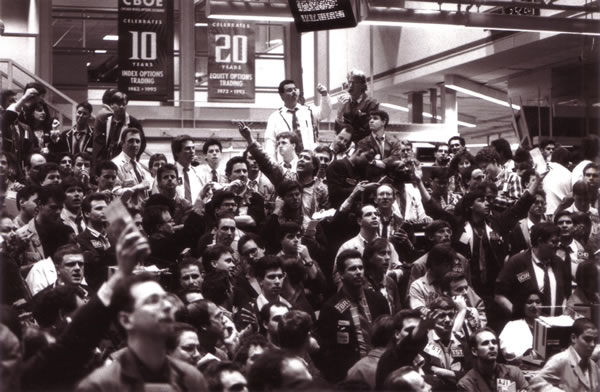MarketsMuse Strike Price update profiles a “return from the past and into the future” look at what many veteran (and former) option mart floor traders had all but given up for lost thanks to the electronification and bifurcation of institutional options trading.
We’re talking about those legacy, open-outcry trading pits, one -time bastions for burly and sharp-elbowed boys from Brooklyn and college ball-players-turned-options market makers and brokers who had reserved trading pit spots for them congregate and serve as liquidity centers for investors and upstairs traders to route and execute both small retail orders and large/complex institutional options orders. According to an article in today’s edition of the MarketsMedia.com newsletter, the options market is having a “Its Déjà vu all over again” moment.
Those who have been around for more than 15 minutes lament the fact that in recent years, those brick and mortar venues have become mere shells of their former selves and in some cases, ghost towns. The American Stock Exchange, arguably the pioneer in options pit trading, was acquired by the NYSE a few years back and is now literally a vacant lot that real estate developers hope to convert into a luxury rental and retail space. Beantown’s BOX might as well be a bowling alley, as trading via that venue is all electronic. One can hear a pin drop on the floor of the CBOE thanks to the ISE, the options market “Dominator” and a completely virtual exchange that has no physical structure other than corporate office space for their execs, and is otherwise comprised of air-conditioned warehouses patrolled by security dogs to protect rows of rack space for computer servers.

Noted John Houlhan, the COO of OMEX Systems, a long time, broker-favored OEMS platform (recently acquired by fintech firm Raptor Trading) and first designed exclusively for agency-only options and ETF floor brokerages operating on the AMEX and since embraced by a number of “upstairs” executing brokers, prop shops and select hedge funds, “Other than a handful of firms that were rolled up, most legacy floor brokerage firms and market-making firms turned in their trading smocks and floor badges long ago.” Added Houlahan, “The others who are relevant in the course of facilitating large block and/or complex options orders for institutional clients or hedge funds now generally operate from loft spaces in tony areas in Chicagoland, offices in various parts of Manhattan and New Jersey offices adjacent to exchange co-location areas.”
BUT WAIT! Everything you just read in that last paragraph is not entirely true; open outcry options trading floors are as relevant as ever, according to coverage from financial media firm MarketsMedia.com.. Here’s an extract from today’s edition of their newsletter, including a look at select veteran options market brokers who have lived to tell the tale…
In a financial world increasingly dominated by screen-based electronic trading, the floor of the NYSE Amex Options exchange is proof that face-to-face trading is not only a key component of its business but it is thriving.
“On any given day, NYSE Amex and Arca options exchanges see 25-40% of total volume coming from participation in our open outcry environment,” said James Hyde, Senior Director for NYSE Options.
One reason for this is the value that the floor provides. For example, an electronic trading platform might quote a call options contract $2.20-$2.80, i.e. a customer could buy the right to purchase 100 shares at a specified price by a specified date for $2.80, or sell that same right for $2.20. Clicking buy or sell could result in a slightly better executed price, but the brokers on the floor are able to probe the bid-ask gap to obtain the ‘true’ price for the best customer execution.
“The value that can be provided by floor firms is price discovery and liquidity beyond what they see on the screen, i.e. the true price,” said Kirk Katzburg, managing partner at DLB Securities and a 21-year trading-floor veteran.
Data shows that the share of electronic options trading has plateaued, suggesting — as Mark Twain might say — that the demise of options floor trading has been greatly exaggerated. Electronic options trading in the U.S. ramped up from 47% in 2005 to 85% in 2010, but then the rate of increase leveled to 87% in 2012 and 89% in 2014, according to Aite Group.
Floor traders historically have left the trading of single-stock names with great displayed liquidity such as Google, Apple and Microsoft, and options such as the iShares MSCI Emerging Markets Index ETF (EEM), to the screens that can offer spreads as tight as one penny for standard lot sizes. The traders’ raison d’etre comes into play for very large or complex orders in less-liquid contracts, where experience, understanding of the market and relationships can make a big difference. For a very large options trade, just dropping the order onto a lit exchange almost assures inefficient execution. “When a trade is done right it’s like a big tanker going down the Hudson River at night — you don’t know it passed, but it went through,” Doyle said. “You can’t be hitting piers and pumps.”
“Sometimes a market on the screen is so wide, it’s really just a suggestion,” Doyle continued. “There’s a lot of wiggle room and room for negotiation in there. That’s where the floor guys come in.”
“Without outcry dialogue, one is left to display size and price across 2,530 names, which equals 643,880 strikes,” Hyde said. “Electronic liquidity providers cannot always give customers the quality and size that can be obtained on the floor.”
Added Hyde, “when a floor broker enters a crowd, he truly has the best of both worlds in his ability to avail himself of a displayed market on the 11 other exchanges that make up that National Best Bid and Offer (NBBO), while also working through additional liquidity being added in the open outcry floor markets.”
With the NYSE Arca Options trading floor in San Francisco and the new Buttonwood Room for the NYSE Amex Options floor in New York City, NYSE is the only exchange operator to support two distinct open outcry trading floors.
“Amex and Arca recently had nearly identical market shares of about 8.6%, good for #5 and #6 among the 12 U.S. options exchanges. And equally important, floor trading generated more than 26% of combined Amex and Arca volume last year.” said Steve Crutchfield, NYSE VP, Options Markets, ETPs and Bonds.
Reopened in January 2015 after a year-long remodel, the 7,000 square-foot Buttonwood Room is the market-hours home to more than 250 brokers, clerks, market makers, clearing-firm employees and support staff. The new venue is home to NYSE Amex Options, as well as U.S. cash equities traders, ICE Futures U.S. market participants, and the NYSE U.S. Cash Markets customer service desk.
For those who can’t envision what an open-outcry trading floor resembles, here’s a look at yesterday’s version..

